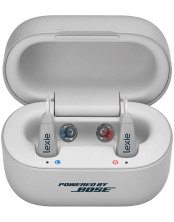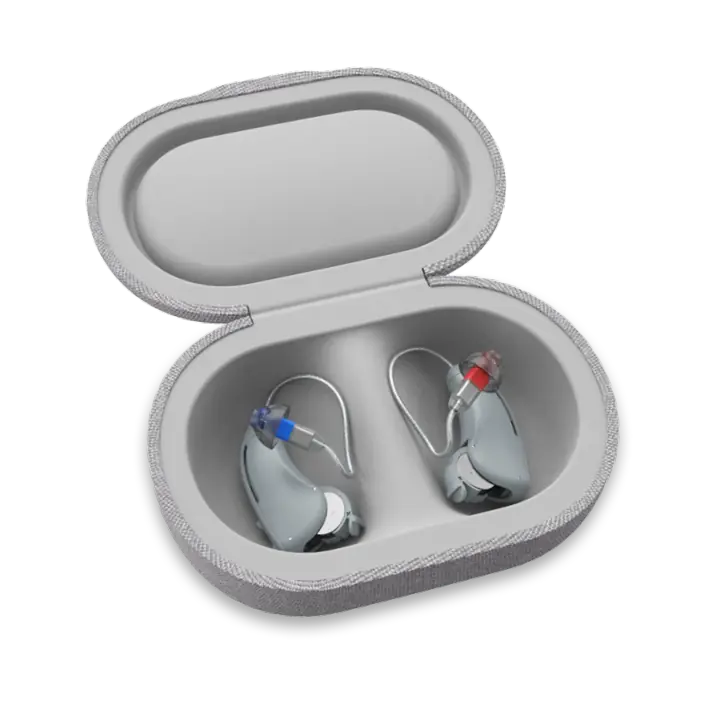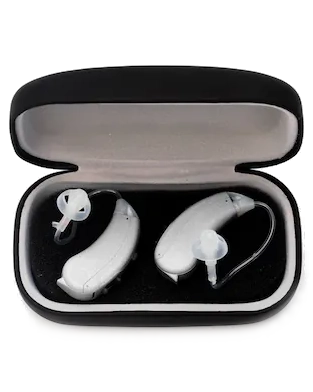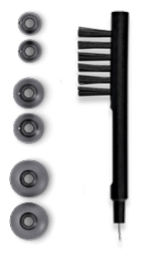Hearing Aid Repairs | What to Expect
Published: May 19, 2021
Updated: July 21, 2022
Hearing aids are made to withstand daily use and are surprisingly sturdy little devices. However, to prolong the lifespan of hearing aids and avoid the need for repairs, regular cleaning and maintenance are important. Even with the greatest of care, ordinary wear and tear or accidents can mean that hearing aids sometimes have to be sent for servicing or repairs by the manufacturer.
To understand what can go wrong with a hearing aid, it is helpful to know the parts that make a hearing aid work:
- A microphone picks up sound and converts it to a digital signal.
- The signal is sent to an amplifier where it is made louder.
- The amplified signal is sent to the receiver (speaker) where it is converted back to sound.
- The sound travels out of the receiver through a slim tube into the ear canal.
If something goes wrong with any of the components, you may find that your hearing aid does not turn on at all, it may turn on but does not make sound louder or as loud as usual, it could work intermittently or sounds could be unclear or distorted.
Before sending your hearing aid to the manufacturer for repairs, it’s important to determine if it’s really necessary. When a hearing aid stops working properly, there is often a simple problem that you can fix at home. If your hearing aid still doesn’t work after troubleshooting and contacting support, it will need to be sent for repairs.
What happens when your hearing aids go in for repair?
Technicians note the fault reported by the user. They then perform various checks to diagnose and repair the problem:
- Listening test: Technicians conduct a listening test. They physically listen to the sound produced by the hearing aid to determine if there are any obvious problems with the sound.
- Visual check: Technicians visually inspect the outside and inside of the device under a microscope. They check for any visible signs of corrosion or moisture. They inspect the status of the tubing, all parts, and all wiring connections and contacts.
- Performance tests: Technicians use very sensitive hearing aid analyzers and specialized diagnostic software to determine a hearing aid’s performance. They measure the sound the faulty hearing aid produces in response to sounds played into the hearing aid. They compare the hearing aid’s performance to the manufacturer’s technical specifications. By testing the hearing aid’s response at different stages of the hearing aid circuit, they can determine if each component is functioning normally and isolate the faulty component. They test the maximum sound output of the device to see if it delivers the loudness of sounds promised by the manufacturer. They also analyze distortion to see if the device delivers the clarity of sound necessary. They check that the hearing aid’s features, such as directionality and noise reduction, are functioning. They may also conduct a battery drain test to determine if the device is drawing power normally.
- Wireless and telecoil function tests: Technicians may test whether the device’s wireless function and telecoil are working normally.
- Checking replacement parts: If technicians find a defect with a component, the component is replaced, and performance tests are repeated. If the results continue to be abnormal, they explore the possibility that another component is problematic. This process is repeated until the hearing aid performs according to the manufacturer’s specifications.
Why are repairs so expensive?
Most manufacturers service or repair hearing aids at no charge if the devices are still under warranty. Be mindful that the warranty will be voided if damage caused by moisture or negligence is noted. Assessing and servicing or repairing a faulty hearing aid is a technical and timely process that influences the costs quoted for out-of-warranty hearing aids. If the hearing aid requires a basic service, which usually involves a thorough external and internal cleaning and replacing of slim tubes and domes, which are relatively inexpensive parts, the service isn’t likely to be very costly. Replacing the microphone or receivers is more costly and is generally considered a minor repair. Hearing aid repairs can be costly if technicians need to conduct a major repair that involves replacing the amplifier, the most expensive replacement part, or if they have to refurbish the hearing aid by replacing multiple components.
What are the main causes of hearing aid damage?
Generally, the outside parts of a hearing aid are the most susceptible to damage, such as the microphone and tubing that can get easily blocked or damaged.
- Wax: Wax is the biggest culprit that causes a hearing aid not to work properly. If the slim tube and/or dome become blocked with wax, the sound will not travel well from the hearing aid into your ear. Fortunately, this is usually a problem that can be solved at home by cleaning or replacing the blocked part. Regularly cleaning the slim tube and dome will prevent this from happening.
- Moisture: Moisture can cause parts of the hearing aid to corrode, especially if you live along the coastline. This is a common problem. To avoid this, leave the battery doors of your hearing aids open to allow excess moisture to escape when you are not using them. Overnight, keep them in an airtight container with a drying capsule that draws out moisture.
- Improper handling or storage: If the slim tube or receiver wire bends or breaks, the sound will not travel well from the hearing aid into your ear. Fortunately, the damaged tube can be changed at home without having to send the hearing aid in for repairs. It is important to take care when inserting, removing, and cleaning your slim tubes.
- Dropping a hearing aid: Often the damage is not visible as the force can damage the inner components of the hearing aid. It is important to ensure there is a soft surface underneath you when inserting, removing, and cleaning your hearing aids.
- Heat and sunlight: Placing hearing aids in direct sunlight and near the heat can also damage them. Leaving your hearing aids lying around can mean pets, which are often attracted to ear wax, can get hold of them. It is therefore important to store your hearing aids properly.
- Chemicals: Products such as hairspray, make-up, and sunscreen can block or damage the hearing aid’s microphone and other internal components. Make sure to remove your hearing aids when you apply hair and face products.
There are many ways to unknowingly damage your hearing aids that can be avoided. Taking care of your hearing aids will extend the lifespan of your hearing aids and minimize the need for repairs. Many times, despite how well you care for them, repairs can’t be avoided. Rest assured that when you send hearing aids away for repairs, they are thoroughly restored and checked.






